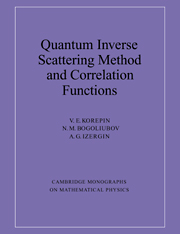Book contents
- Frontmatter
- Contents
- Preface
- Part I The Coordinate Bethe Ansatz
- Part II The Quantum Inverse Scattering Method
- Part III The Determinant Representation for Quantum Correlation Functions
- Part IV Differential Equations for Quantum Correlation Functions
- Introduction to Part IV
- XIII Correlation Functions for Impenetrable Bosons. The Determinant Representation
- XIV Differential Equations for Correlation Functions
- XV The Matrix Riemann-Hilbert Problem for Correlation Functions
- XVI Asymptotics of Temperature-dependent Correlation Functions for the Impenetrable Bose Gas
- XVII The Algebraic Bethe Ansatz and Asymptotics of Correlation Functions
- XVIII Asymptotics of Correlation Functions and the Conformal Approach
- Final Conclusion
- References
- Index
Introduction to Part IV
Published online by Cambridge University Press: 04 August 2010
- Frontmatter
- Contents
- Preface
- Part I The Coordinate Bethe Ansatz
- Part II The Quantum Inverse Scattering Method
- Part III The Determinant Representation for Quantum Correlation Functions
- Part IV Differential Equations for Quantum Correlation Functions
- Introduction to Part IV
- XIII Correlation Functions for Impenetrable Bosons. The Determinant Representation
- XIV Differential Equations for Correlation Functions
- XV The Matrix Riemann-Hilbert Problem for Correlation Functions
- XVI Asymptotics of Temperature-dependent Correlation Functions for the Impenetrable Bose Gas
- XVII The Algebraic Bethe Ansatz and Asymptotics of Correlation Functions
- XVIII Asymptotics of Correlation Functions and the Conformal Approach
- Final Conclusion
- References
- Index
Summary
The quantum correlation functions for different exactly solvable (completely integrable) models are all constructed in a similar way. In Part IV our main example will be the nonlinear Schrödinger (NS) equation. We shall also comment on the other models: the Heisenberg antiferromagnet, the Hubbard model and so on.
We shall discuss different approaches to quantum correlation functions. Our main approach leads to differential equations for quantum correlation functions. These are classical nonlinear differential equations; they are completely integrable and closely related to the original classical differential equation that was quantized (the NS equation in our case).
In the first stage of calculation of correlation functions we represent them as a determinant of some Predholm integral operator (here we shall use the results of Part III). The correct language for the description of quantum correlation functions is the language of τ functions, which was developed in. This helps us to relate the differential equations for quantum correlation functions with the hierarchy of the original classical differential equation that was quantized (the NS equation in our example). In this way we solve the most difficult problem; that of the evaluation of time-and temperature-dependent correlation functions.
This approach can be applied not only to correlation functions for the NS equation, but also to the sine-Gordon model, to non-relativistic fermions, to the Heisenberg antiferromagnetic with special anisotropy and to other models.
- Type
- Chapter
- Information
- Quantum Inverse Scattering Method and Correlation Functions , pp. 281 - 282Publisher: Cambridge University PressPrint publication year: 1993



